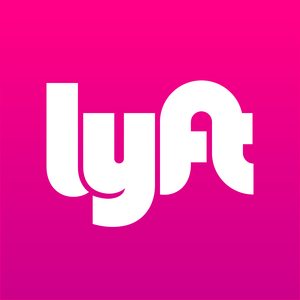
Lyft (LYFT)
Lyft is intriguing. It not only produces heaps of cash but also has improved its profitability, showing its quality is rising.― StockStory Analyst Team
1. News
2. Summary
Why Lyft Is Interesting
Founded by Logan Green and John Zimmer as a long-distance intercity carpooling company Zimride, Lyft (NASDAQ: LYFT) operates a ridesharing network in the US and Canada.
- Performance over the past three years shows its incremental sales were extremely profitable, as its annual earnings per share growth of 33.8% outpaced its revenue gains
- Strong engagement trends coupled with 8.6% annual growth in its average revenue per user demonstrate its platform’s stickiness with die-hard customers
- One pitfall is its gross margin of 34.6% is below its competitors, leaving less money to invest in areas like marketing and R&D


Lyft has some respectable qualities. If you’re a believer, the price looks fair.
Why Is Now The Time To Buy Lyft?
High Quality
Investable
Underperform
Why Is Now The Time To Buy Lyft?
Lyft is trading at $22.41 per share, or 14.5x forward EV/EBITDA. Compared to companies in the consumer internet space, we think this multiple is warranted for the revenue growth you get.
Now could be a good time to invest if you believe in the story.
3. Lyft (LYFT) Research Report: Q3 CY2025 Update
Ride sharing service Lyft (NASDAQ: LYFT) fell short of the markets revenue expectations in Q3 CY2025, but sales rose 10.7% year on year to $1.69 billion. Its GAAP profit of $0.11 per share was 53.6% above analysts’ consensus estimates.
Lyft (LYFT) Q3 CY2025 Highlights:
- Revenue: $1.69 billion vs analyst estimates of $1.70 billion (10.7% year-on-year growth, 1.2% miss)
- EPS (GAAP): $0.11 vs analyst estimates of $0.07 (53.6% beat)
- Adjusted EBITDA: $138.9 million vs analyst estimates of $139.8 million (8.2% margin, 0.6% miss)
- Q4 Guidance: Gross Bookings of approximately $5.01 billion to $5.13 billion, up approximately 17% to 20% year over year (beat)
- Operating Margin: 1.4%, up from -3.7% in the same quarter last year
- Free Cash Flow Margin: 0%, down from 20.7% in the previous quarter
- Active Riders: 28.7 million, up 4.3 million year on year
- Market Capitalization: $7.89 billion
Company Overview
Founded by Logan Green and John Zimmer as a long-distance intercity carpooling company Zimride, Lyft (NASDAQ: LYFT) operates a ridesharing network in the US and Canada.
Uber created the first ride hailing app, allowing users to summon black limousines via their mobile devices, an innovation that disrupted modern transportation. Lyft followed and expanded the service to the mass market, positioning it as a casual, friendly carpool experience that aimed to appeal to younger generations. Initially, Lyft’s drivers had a pink mustache affixed to the grill of their car, which has since been replaced by an “Amp” device, which lights up the car’s dashboard to help riders easily find their car.
The company’s value propositions are multiple. For individuals, Lyft effectively lowered the cost per mile for taxi transportation vs. legacy cabs, while providing ease of use and convenience. For drivers, it has provided flexible earning opportunities.
4. Gig Economy
The iPhone changed the world, ushering in the era of the “always-on” internet and “on-demand” services - anything someone could want is just a few taps away. Likewise, the gig economy sprang up in a similar fashion, with a proliferation of tech-enabled freelance labor marketplaces, which work hand and hand with many on demand services. Individuals can now work on demand too. What began with tech-enabled platforms that aggregated riders and drivers has expanded over the past decade to include food delivery, groceries, and now even a plumber or graphic designer are all just a few taps away.
Lyft’s (NASDAQ: LYFT) main competitor in ride hailing is Uber (NYSE:UBER).
5. Revenue Growth
Examining a company’s long-term performance can provide clues about its quality. Even a bad business can shine for one or two quarters, but a top-tier one grows for years. Thankfully, Lyft’s 17.3% annualized revenue growth over the last three years was solid. Its growth beat the average consumer internet company and shows its offerings resonate with customers, a helpful starting point for our analysis.

This quarter, Lyft’s revenue grew by 10.7% year on year to $1.69 billion but fell short of Wall Street’s estimates.
Looking ahead, sell-side analysts expect revenue to grow 14.3% over the next 12 months, a deceleration versus the last three years. Despite the slowdown, this projection is commendable and suggests the market is forecasting success for its products and services.
6. Active Riders
User Growth
As a gig economy marketplace, Lyft generates revenue growth by expanding the number of services on its platform (e.g. rides, deliveries, freelance jobs) and raising the commission fee from each service provided.
Over the last two years, Lyft’s active riders, a key performance metric for the company, increased by 11.2% annually to 28.7 million in the latest quarter. This growth rate is strong for a consumer internet business and indicates people love using its offerings. 
In Q3, Lyft added 4.3 million active riders, leading to 17.6% year-on-year growth. The quarterly print was higher than its two-year result, suggesting its new initiatives are accelerating user growth.
Revenue Per User
Average revenue per user (ARPU) is a critical metric to track because it measures how much the company earns in transaction fees from each user. This number also informs us about Lyft’s take rate, which represents its pricing leverage over the ecosystem, or "cut" from each transaction.
Lyft’s ARPU growth has been impressive over the last two years, averaging 8.6%. Its ability to increase monetization while quickly growing its active riders reflects the strength of its platform, as its users continue to spend more each year. 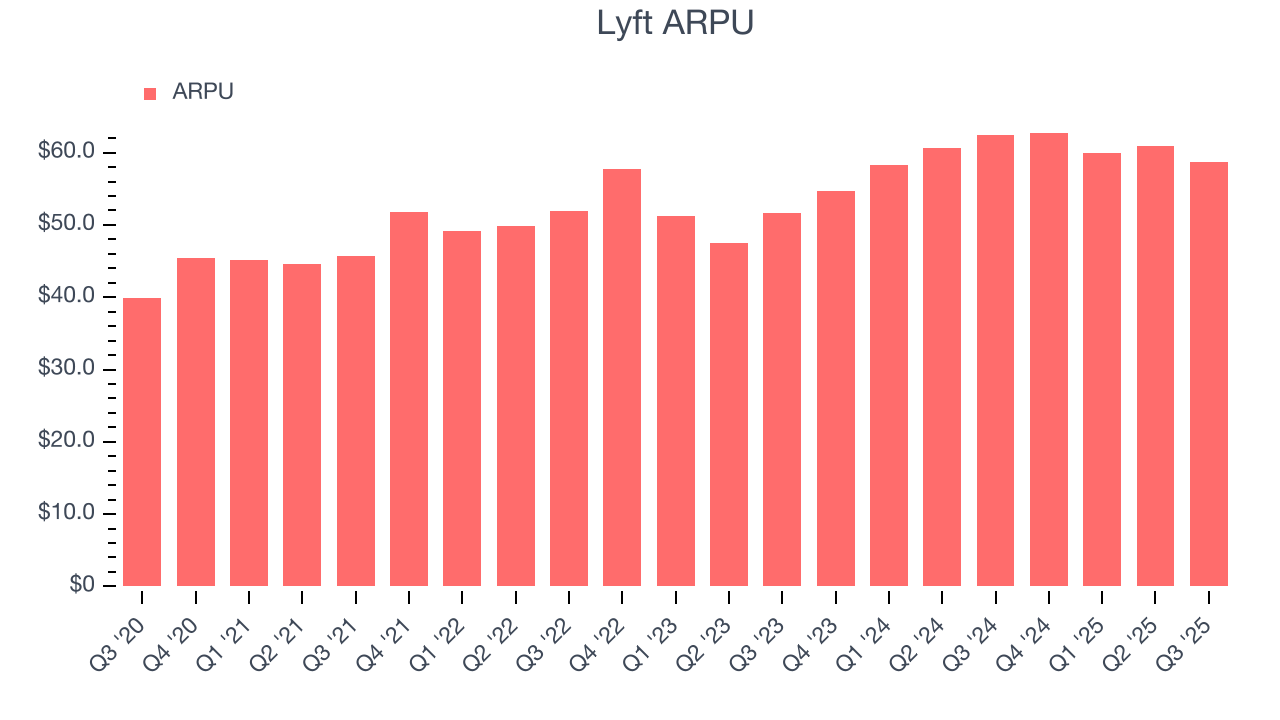
This quarter, Lyft’s ARPU clocked in at $58.72. It declined 5.9% year on year, worse than the change in its active riders.
7. Gross Margin & Pricing Power
For gig economy businesses like Lyft, gross profit tells us how much money the company gets to keep after covering the base cost of its products and services, which typically include server hosting, customer support, and payment processing fees. Another cost of revenue could also be insurance to protect against liabilities arising from providing transportation, housing, or freelance work services.
Lyft’s unit economics are far below other consumer internet companies, signaling it operates in a competitive market and must pay many third parties a slice of its sales to distribute its products and services. As you can see below, it averaged a 35.7% gross margin over the last two years. Said differently, Lyft had to pay a chunky $64.27 to its service providers for every $100 in revenue. 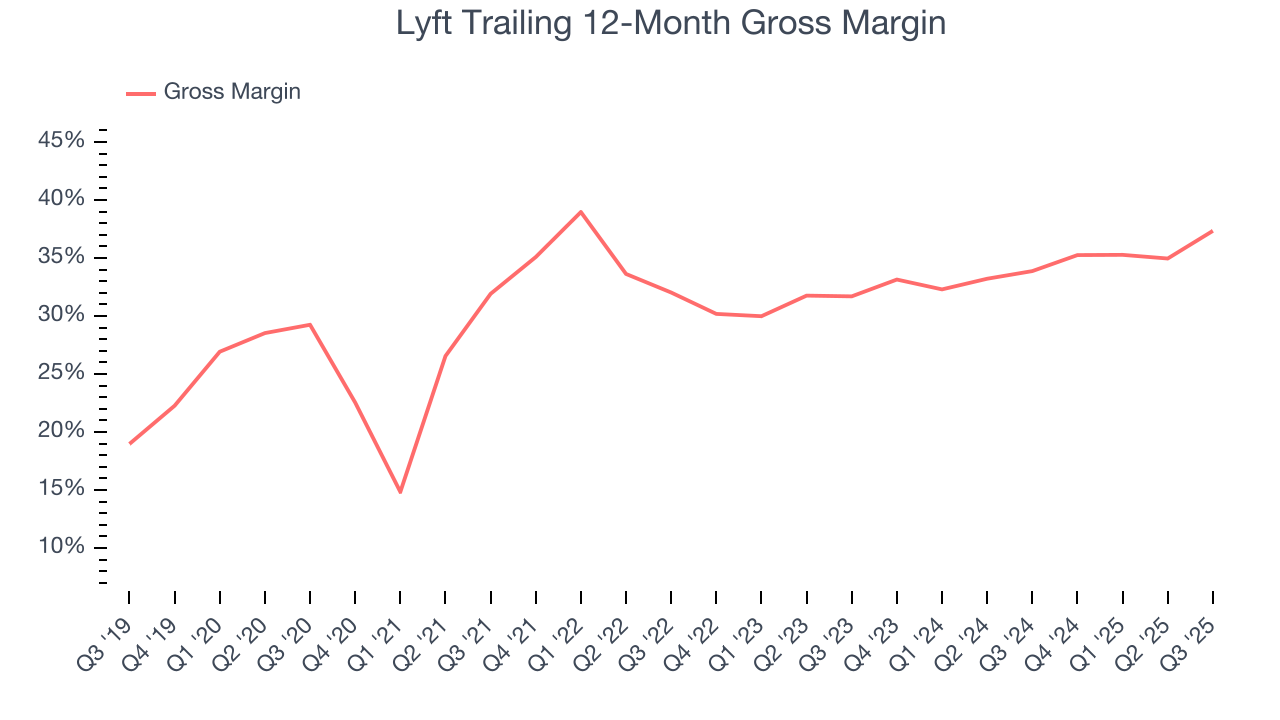
In Q3, Lyft produced a 45% gross profit margin, up 8.8 percentage points year on year. Lyft’s full-year margin has also been trending up over the past 12 months, increasing by 3.5 percentage points. If this move continues, it could suggest better unit economics due to more leverage from its growing sales on the fixed portion of its cost of goods sold (such as servers).
8. User Acquisition Efficiency
Consumer internet businesses like Lyft grow from a combination of product virality, paid advertisement, and incentives (unlike enterprise software products, which are often sold by dedicated sales teams).
Lyft is efficient at acquiring new users, spending 37.4% of its gross profit on sales and marketing expenses over the last year. This efficiency indicates relatively solid competitive positioning, giving Lyft the freedom to invest its resources into new growth initiatives. 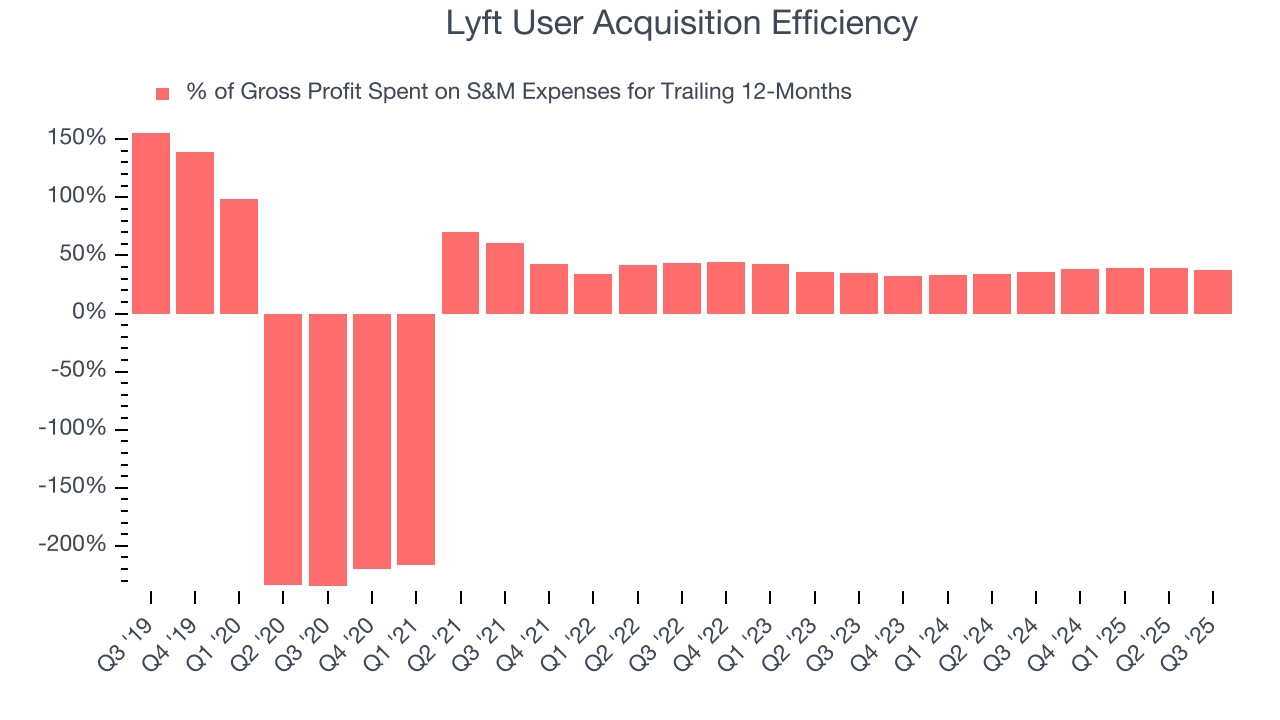
9. EBITDA
Lyft has managed its cost base well over the last two years. It demonstrated solid profitability for a consumer internet business, producing an average EBITDA margin of 7%. This result was particularly impressive because of its low gross margin, which is mostly a factor of what it sells and takes huge shifts to move meaningfully. Companies have more control over their operating margins, and it’s a show of well-managed operations if they’re high when gross margins are low.
Looking at the trend in its profitability, Lyft’s EBITDA margin rose by 13.3 percentage points over the last few years, as its sales growth gave it operating leverage.
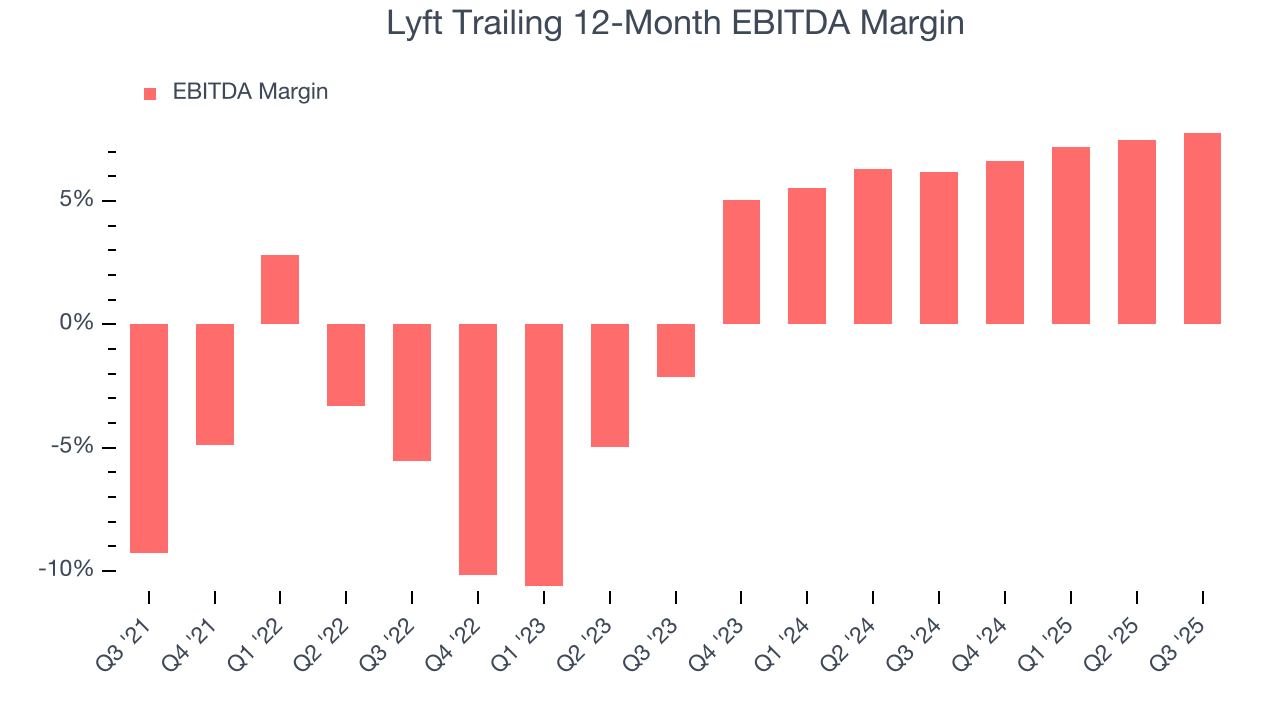
In Q3, Lyft generated an EBITDA margin profit margin of 8.2%, up 1.2 percentage points year on year. Since its gross margin expanded more than its EBITDA margin, we can infer that leverage on its cost of sales was the primary driver behind the recently higher efficiency.
10. Earnings Per Share
We track the change in earnings per share (EPS) for the same reason as long-term revenue growth. Compared to revenue, however, EPS highlights whether a company’s growth is profitable.
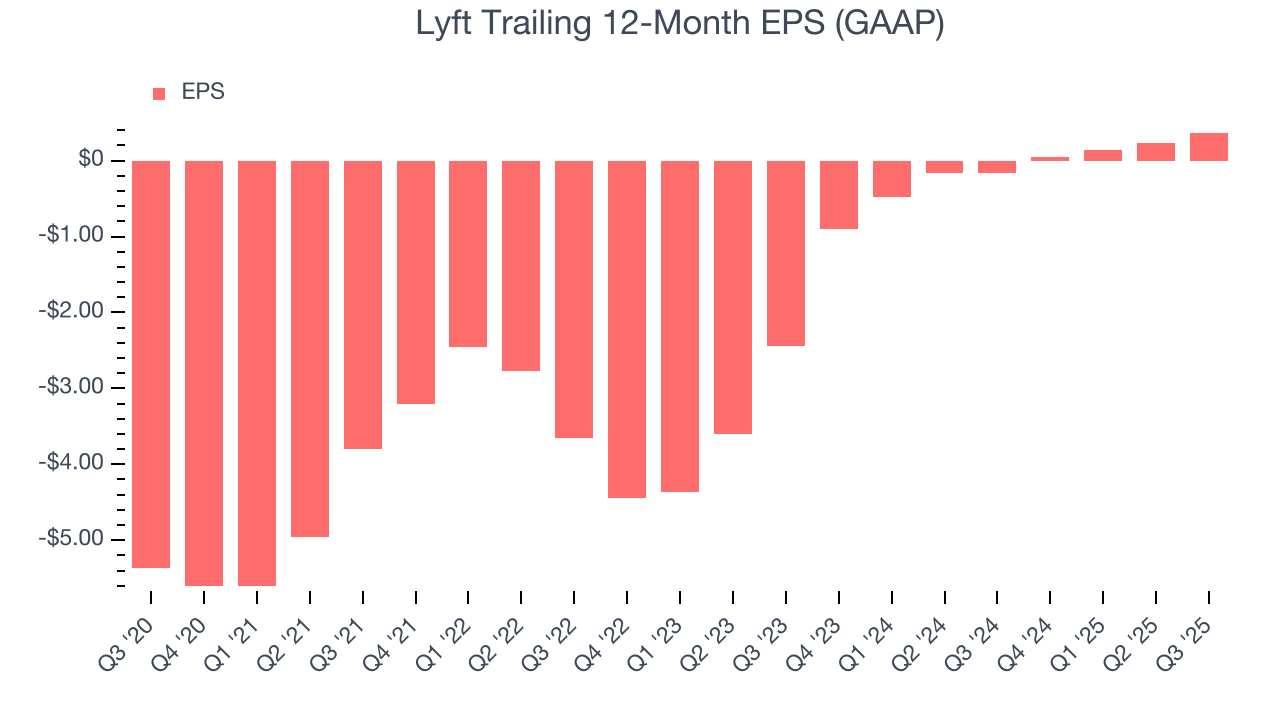
In Q3, Lyft reported EPS of $0.11, up from negative $0.03 in the same quarter last year. This print easily cleared analysts’ estimates, and shareholders should be content with the results. Over the next 12 months, Wall Street expects Lyft’s full-year EPS of $0.37 to grow 17%.
11. Cash Is King
Although EBITDA is undoubtedly valuable for assessing company performance, we believe cash is king because you can’t use accounting profits to pay the bills.
Lyft has shown impressive cash profitability, driven by its cost-effective customer acquisition strategy that gives it the option to invest in new products and services rather than sales and marketing. The company’s free cash flow margin averaged 11.9% over the last two years, better than the broader consumer internet sector.
Taking a step back, we can see that Lyft’s margin expanded by 20.6 percentage points over the last few years. This is encouraging, and we can see it became a less capital-intensive business because its free cash flow profitability rose more than its operating profitability.

Lyft broke even from a free cash flow perspective in Q3. The company’s cash profitability regressed as it was 15.9 percentage points lower than in the same quarter last year, but we wouldn’t read too much into the short term because investment needs can be seasonal, causing temporary swings. Long-term trends are more important.
12. Balance Sheet Assessment
Companies with more cash than debt have lower bankruptcy risk.

Lyft is a profitable, well-capitalized company with $2.36 billion of cash and $1.19 billion of debt on its balance sheet. This $1.17 billion net cash position is 14.9% of its market cap and gives it the freedom to borrow money, return capital to shareholders, or invest in growth initiatives. Leverage is not an issue here.
13. Key Takeaways from Lyft’s Q3 Results
It was encouraging to see Lyft beat analysts’ number of active riders expectations this quarter. We were also glad it expanded its number of users. Looking ahead, Q4 guidance for gross bookings came in ahead of expectations. On the other hand, its revenue slightly missed Wall Street’s estimates. Overall, this was still a solid quarter. The stock traded up 2.5% to $20.62 immediately after reporting.
14. Is Now The Time To Buy Lyft?
Updated: December 4, 2025 at 9:12 PM EST
Before deciding whether to buy Lyft or pass, we urge investors to consider business quality, valuation, and the latest quarterly results.
In our opinion, Lyft is a solid company. First off, its revenue growth was solid over the last three years. And while its gross margins make it extremely difficult to reach positive operating profits compared to other consumer internet businesses, its rising cash profitability gives it more optionality. On top of that, its EPS growth over the last three years has been fantastic.
Lyft’s EV/EBITDA ratio based on the next 12 months is 14.5x. When scanning the consumer internet space, Lyft trades at a fair valuation. If you believe in the company and its growth potential, now is an opportune time to buy shares.
Wall Street analysts have a consensus one-year price target of $24.33 on the company (compared to the current share price of $22.54), implying they see 8% upside in buying Lyft in the short term.











